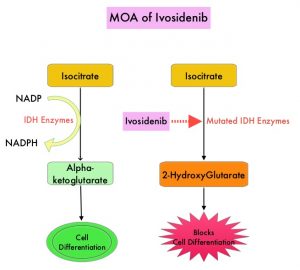SUMMARY: ERG (ETS-Related Gene) is a known oncogene located on chromosome 21, and is a member of the ETS (erythroblast transformation-specific) family of transcription factors. The ERG gene encodes for a protein also called ERG that functions as a transcriptional regulator, and regulates differentiation of early hematopoietic cells.
ERG has been linked to Down syndrome- associated Acute Megakaryocytic Leukemia. ERG typically via gene-fusions can lead to dysregulated ERG overexpression in hematologic malignancies and solid tumors. ERG can fuse with TMPRSS2 protein to form an oncogenic fusion gene that is commonly found in Hormone-Refractory Prostate Cancer, suggesting that ERG overexpression may contribute to development of androgen-independence in prostate cancer through disruption of androgen receptor signaling. EWS1-ERG fusion has been noted in 10% of Ewing’s Sarcoma cases. ERG is also involved in oncogenesis by generating fusion genes with FUS/TLS in Acute Myeloid Leukemia.
The researchers in this study identified a germline ERG variant associated with bone marrow failure and hematological malignancies. The study originated from a family case involving thrombocytopenia and neutropenia, where the mother developed Acute Myeloid Leukemia (AML) and MyeloDysplastic Syndrome (MDS). ERG, a known oncogene, was discovered as a predisposition gene for bone marrow failure and hematological malignancy. A germline ERG ETS domain variant (p.Y373C) was identified, segregating with thrombocytopenia in a family, leading to AML and therapy-related MDS. Copy neutral Loss of Heterozygosity of chromosome 21q, including the ERG locus, was observed in affected individuals. Validation of their findings involved functional assays, demonstrating Loss of Function variants in ERG, affecting DNA binding and nuclear localization. Experiments using a fetal liver assay confirmed the role of ERG in cytokine-independent growth and leukemia development.
Through global collaborations, 15 heterozygous variants in the ERG gene were identified, including 13 missense and 2 truncating variants in 17 individuals with cytopenia, hematological malignancy or lymphedema. Of these 15 variants, 12 have been confirmed germline. Onset of hematological symptoms ranged from birth to 38 years for truncating and constrained ETS domain variants. Functional studies revealed that most ETS domain missense variants displayed Loss-of-Function (LOF) characteristics affecting transcriptional transactivation, DNA binding, and/or nuclear localization.
This ERG syndrome parallels GATA2 deficiency syndrome (hematological malignancy with lymphedema) and RUNX1 Familial Platelet disorder-myeloid malignancy (thrombocytopenia and hematological malignancy). ERG, like the well-known disease genes GATA2, and RUNX1 is a member of the transcription factor heptad involved in hematopoietic stem cell maintenance and differentiation.
The researchers concluded that germline ERG variants predispose to diverse cytopenia, bone marrow failure and hematological malignancies in both children and adults and ERG adds to a growing list of genes whose unregulated expression contributes to hematological malignancy and other cancers. Identification of germline ERG variants has direct clinical implications for patient and family management including diagnosis, counseling, surveillance, and treatment strategies, such as bone marrow transplant and targeted therapies. Potential clinical implications include ERG screening in germline panels for bone marrow failures and hematological malignancies. Additionally there is a need for further longitudinal studies to understand the natural history of ERG-related syndromes.
ERG is a New Predisposition Gene for Bone Marrow Failure and Hematological Malignancy. Scott HS, Zerella J, Homan C, et al. ASH Annual Meeting & Exposition 2023. LBA-6.

